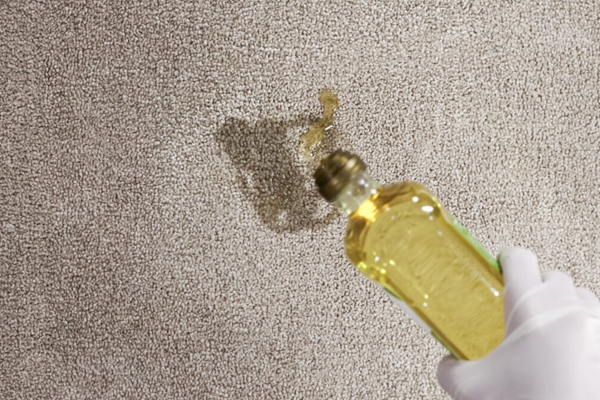Blog
How To Get Cooking Oil Stains Out Of Carpet?
Cooking oil stains on carpets are a common and frustrating issue many households face. Whether it’s from a kitchen mishap or an accidental spill, these oily stains can quickly penetrate carpet fibers, making them difficult to remove. If you’ve been searching for “how to get cooking oil stains out of carpet” or “how do you get cooking oil out of carpet,” you’re in the right place. This article provides effective, step-by-step solutions to tackle those stubborn stains and restore your carpet’s pristine condition. Read on to discover practical tips and tricks that will help you eliminate cooking oil stains from your carpet for good.

Key Takeaways by How To Get Cooking Oil Stains Out Of Carpet
- Prompt action is crucial: The sooner you address a cooking oil stain, the easier it will be to remove.
- Household products to the rescue: Common items like baking soda, dish soap, and vinegar can effectively combat oil stains.
- Professional cleaning: For particularly stubborn stains, enlisting professional cleaning services may be necessary.
- Regular maintenance: Preventive measures and regular carpet care can help avoid permanent damage and keep your carpet looking fresh.
Immediate Actions and Home Remedies
Understanding the Challenge of Oil Stains
Cooking oil stains are particularly challenging to remove from carpets due to the nature of oil. Oil doesn’t mix with water and tends to cling to carpet fibers, making it difficult to lift and remove. When oil penetrates the carpet, it seeps deep into the fibers, binding tightly and creating a stubborn stain. The longer the oil remains, the more it sets, and if not treated promptly, it can lead to permanent discoloration and damage. Understanding this challenge is the first step toward effectively tackling and removing these pesky stains.
Immediate Steps to Take When Oil Spills
When cooking oil spills on your carpet, quick action is essential. Here are the immediate steps to follow:
- Blot the Excess Oil: Use paper towels or a clean cloth to gently blot the oil. Press down lightly to absorb as much oil as possible without rubbing, as rubbing can spread the oil and push it deeper into the carpet fibers.
- Avoid Rubbing: One common mistake is rubbing the stain, which can make it worse. Instead, blot the area gently to lift the oil.
- Use a Spoon or Knife: If the spill is significant, use a spoon or dull knife to scrape off the excess oil carefully. Be cautious not to damage the carpet fibers.
These immediate steps help minimize the oil’s penetration into the carpet, making the subsequent cleaning process more effective.
Home Remedies for Removing Cooking Oil Stains
Several household products can effectively tackle cooking oil stains:
- Baking Soda or Cornstarch: Sprinkle a generous amount of baking soda or cornstarch over the stain. These powders are excellent for absorbing oil. Let it sit for 15-20 minutes before vacuuming it up.
- Dish Soap Solution: Mix a few drops of dish soap with warm water to create a soapy solution. Apply it to the stain using a clean cloth, gently blotting to break down the oil.
- White Vinegar and Water: Combine equal parts white vinegar and water in a spray bottle. Spray the mixture onto the stain and blot with a clean cloth. Vinegar helps to cut through the oil and provides additional cleaning power.
Step-by-Step Guide to Removing Fresh Oil Stains
Follow these detailed steps for each home remedy to ensure thorough removal:
Baking Soda or Cornstarch Method
- Sprinkle the powder liberally over the oil stain.
- Let it sit for at least 15-20 minutes to absorb the oil.
- Vacuum the area thoroughly to remove the powder and lifted oil.
Dish Soap Solution Method
- Mix a few drops of dish soap with warm water.
- Dip a clean cloth into the soapy solution.
- Blot the stain gently, working from the outside toward the center.
- Rinse the area with a cloth dampened with clean water to remove any soapy residue.
- Blot dry with a clean towel.
White Vinegar and Water Method
- Mix equal parts white vinegar and water in a spray bottle.
- Spray the solution onto the oil stain.
- Blot the area with a clean cloth, repeating as necessary until the stain lifts.
- Rinse with clean water and blot dry.
By following these steps and tips, you can effectively remove fresh cooking oil stains from your carpet, ensuring a clean and stain-free surface.
Deep Cleaning and Professional Help
Removing Set-In Oil Stains
Dealing with set-in oil stains requires more intensive methods. Here are some effective solutions:
Carpet Cleaners Designed for Oil Stains
Many commercial carpet cleaners are formulated specifically to tackle oil-based stains. These cleaners contain strong detergents that break down oil molecules. Follow the instructions on the product label, ensuring to apply it generously to the stained area.
Hydrogen Peroxide for Tougher Stains
Hydrogen peroxide can be a powerful agent against stubborn oil stains. Mix one part hydrogen peroxide with two parts water and apply it to the stain using a clean cloth. Allow it to sit for a few minutes before blotting it up. Always test a small, inconspicuous area of the carpet first to ensure it doesn’t cause discoloration.
Testing a Small Area First
- Before applying any cleaning solution extensively, test it on a small, hidden section of the carpet. This step is crucial to avoid any potential damage or discoloration.
- Using these methods can help lift even the most stubborn oil stains from your carpet, restoring its original appearance.
Professional Carpet Cleaning Solutions
When home remedies and DIY solutions aren’t enough, it may be time to call in the professionals.
Benefits of Hiring Professionals
Professional carpet cleaners have access to industrial-grade equipment and specialized cleaning solutions that are more effective at removing deep-set stains. They can also clean large areas more efficiently and thoroughly.
What to Expect from Professional Cleaning Services
A professional cleaning service will typically start with an inspection of the carpet to determine the best cleaning method. They will then pre-treat stains, perform deep cleaning using hot water extraction or steam cleaning, and ensure proper drying to prevent mold and mildew growth.
Finding a Reliable Carpet Cleaning Service
To find a trustworthy service, look for reviews and ratings online, ask for recommendations from friends or family, and check for certifications from reputable organizations like the Institute of Inspection, Cleaning and Restoration Certification (IICRC).
Preventing Future Oil Stains on Carpets
Prevention is always better than cure. Here are some tips to keep your carpets oil-free:
Using Protective Mats and Rugs
Place mats and rugs in areas prone to spills, such as under kitchen counters and dining tables. These can catch spills before they reach the carpet.
Prompt Action on Spills
As soon as an oil spill occurs, act quickly to blot up as much oil as possible. Immediate action can prevent the oil from setting into the carpet fibers.
Regular Carpet Maintenance Tips
Vacuum your carpets regularly to remove surface dirt and prevent the buildup of grime that can attract and hold oil. Schedule professional cleanings at least once a year to keep your carpets in optimal condition.
Comparing DIY vs. Professional Cleaning for Oil Stains
Choosing between DIY methods and professional cleaning depends on several factors:
Pros and Cons of DIY Methods
DIY methods are cost-effective and convenient for minor stains. However, they may not always be effective on tough or set-in stains and can sometimes cause damage if not done correctly.
Advantages of Professional Services
Professionals have the expertise and equipment to handle stubborn stains more effectively. They can save you time and effort and are generally more thorough in their cleaning.
Cost Comparison and Effectiveness
While professional services come at a higher cost, their effectiveness often justifies the expense, especially for severe or widespread stains. DIY methods are cheaper but may require repeated efforts to achieve desired results.
By understanding the benefits and limitations of each approach, you can make an informed decision on how best to handle cooking oil stains on your carpet.
FAQs on How To Get Cooking Oil Stains Out Of Carpet
Yes, baking soda is an effective home remedy for removing cooking oil stains from carpets. Baking soda works by absorbing the oil, making it easier to lift from the carpet fibers. To use baking soda, follow these steps:
- Blot any excess oil with paper towels.
- Sprinkle a generous amount of baking soda over the stain.
- Let it sit for at least 15-20 minutes to absorb the oil.
- Vacuum the area thoroughly to remove the baking soda and lifted oil.
When attempting to remove oil stains from carpet, avoid these common mistakes:
- Rubbing the Stain: Rubbing can spread the oil further into the carpet fibers, making it harder to remove.
- Using Hot Water: Hot water can cause the oil to penetrate deeper into the carpet.
- Skipping the Blotting Step: Failing to blot the excess oil initially can result in a more stubborn stain.
- Over-Saturating with Cleaner: Using too much cleaning solution can leave residues that attract dirt.
Yes, several commercial products are specifically designed to tackle oil stains on carpets. Some effective options include:
- Folex Instant Carpet Spot Remover: Known for its ability to handle a variety of stains, including oil.
- Resolve Carpet Cleaner: Effective for treating oil and grease stains.
- Bissell Professional Power Shot Oxy: A strong cleaner that targets tough stains and odors.
Conclusion
Removing cooking oil stains from carpets requires prompt action and the right techniques. Key steps include blotting the excess oil, using absorbent powders like baking soda or cornstarch, and applying dish soap or vinegar solutions for thorough cleaning. It’s crucial to avoid rubbing the stain and using hot water, as these can worsen the situation. For stubborn stains, professional cleaning services offer effective solutions. Act quickly, follow the appropriate methods, and maintain your carpet regularly to prevent future stains. For more detailed instructions and additional tips, refer to reputable cleaning resources and guides.
